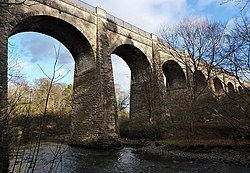Avon Aqueduct
The Avon Aqueduct is a navigable aqueduct that carries the Union Canal over the River Avon, near Linlithgow, Scotland. History The aqueduct was built to a design by Hugh Baird, with advice from Thomas Telford, in tandem with the aqueducts at Slateford and Lin's Mill, with which it shares its design.[1][2] Telford was not convinced that the stone arches were necessary in conjunction with the iron trough, but Baird used both on all three major aqueducts.[1] Construction was carried out by Messrs. Craven, Whitaker and Nowell between 1819 and 1821, their success in building a stone bridge over the River Ouse making their tender for the contract "by far the most eligible".[3] The aqueduct straddles the border between the West Lothian and Falkirk Council areas, so has two Historic Environment Scotland listings.[4][5][6] The aqueduct is a category A listed building.[5][6] Design The Barton Aqueduct of 1761, and subsequent canal aqueducts in the United Kingdom, used large quantities of masonry and puddling to obtain watertightness.[3] After the success of The Iron Bridge in 1789, however, cast iron was used by Telford on aqueducts such as Chirk and Pontcysyllte.[3] Aqueducts built in the early part of the 19th century use either puddle clay or an iron trough in no particular pattern.[7] The Avon Aqueduct uses an iron trough to achieve watertightness, as well as containing the outward pressure of the water, allowing it to be of more slender construction than a purely stone aqueduct such as the Kelvin Aqueduct.[2] It is just over 810 feet (250 m) long including the tapered part of the canal at each end, and 86 feet (26 m) high above the surface of the river.[2] The aqueduct is carried on twelve segmental arches, each of 50 feet (15 m) span.[2] The piers, which are slightly tapered, spring into the arches at a height of 50 feet (15 m) above the river level, and the tops of the arches are 50 feet (15 m) above that point.[2] The piers are hollow, and access to the inside of the structure underneath the trough is gained by a small door 3 feet (0.91 m) high by 2 feet 6 inches (0.76 m) wide.[2] The structure is 23 feet 8 inches (7.21 m) wide at the top, and the canal is 13 feet (4.0 m) wide and around 6 feet (1.8 m) deep due to silting.[2] There are stone towpaths 4 feet (1.2 m) wide along each side.[2] It is the longest and tallest aqueduct in Scotland, and the second longest in Britain, after the Pontcysyllte Aqueduct in Wales.[2] The river passes under the aqueduct at the eastern end, where the aqueduct has a slight curve.[8] It can be viewed from Muiravonside Country Park. See also
References
External linksWikimedia Commons has media related to Avon Aqueduct. |
||||||||||||||||||||||||||||||
Portal di Ensiklopedia Dunia















